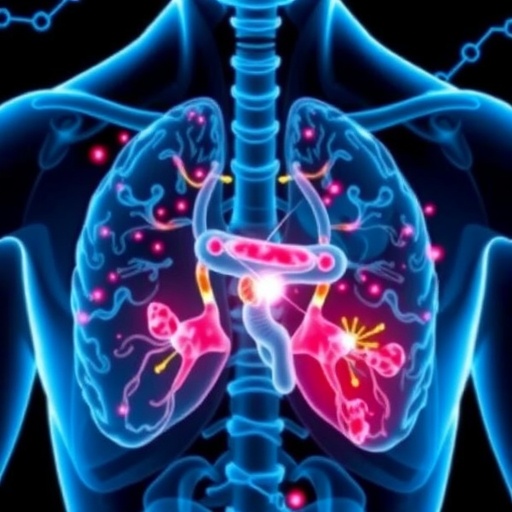Chronic exposure to pesticides has long been a topic of concern, especially in agricultural communities. A recent study led by researchers Putri, Sadewa, and Supangat has unveiled significant findings related to the health impacts of long-term pesticide exposure among farmers in Wuluhan, Jember, Indonesia. This cross-sectional analysis explores the levels of malondialdehyde (MDA) and 8-hydroxydeoxyguanosine (8-OHdG), two biomarkers that serve as indicators of oxidative stress and DNA damage, respectively.
Pesticides are chemical substances used to manage pests in agriculture, yet their harmful effects on human health are increasingly under scrutiny. Farmers, who are the primary handlers of these chemicals, face heightened risks of chronic pesticide exposure, resulting in adverse health outcomes. The study provides crucial insights into how these toxic substances infiltrate the bodies of those who regularly apply them, thereby generating distressing health implications.
Malondialdehyde is a byproduct of lipid peroxidation and is often associated with oxidative stress; elevated MDA levels indicate cellular membrane damage and contribute to the pathogenesis of numerous diseases. On the other hand, 8-OHdG is a biomarker for oxidative DNA damage and is used to evaluate the extent of DNA injury caused by free radicals. Understanding the levels of these markers in farmers is vital for assessing the health risks associated with prolonged pesticide exposure.
The research involved a carefully selected cohort of farmers from Wuluhan, an area characterized by intensive agricultural activities. By employing a cross-sectional study design, the researchers aimed to establish a correlation between pesticide exposure and elevated levels of MDA and 8-OHdG. Participants were subjected to a series of assessments to determine their exposure levels, including interviews regarding pesticide use, duration of exposure, and health check-ups.
One of the critical findings of this study is the clear association between the duration and intensity of pesticide exposure and increased levels of both MDA and 8-OHdG. Farmers who reported frequent pesticide application exhibited significantly higher concentrations of these biomarkers compared to those with minimal exposure. This finding underscores the pressing need for regulation and better practices in pesticide use to safeguard health.
Moreover, the researchers controlled for various confounding factors, such as age, gender, smoking habits, and other environmental exposures, to ensure the validity of their findings. This meticulous approach allows for a robust interpretation of how chronic pesticide exposure may elevate health risks among agricultural workers. It is noteworthy that the observed health implications extend beyond immediate health concerns, hinting at long-term effects that may arise from such exposures.
The implications of this research extend beyond the realm of academia; they call for policy changes aimed at protecting vulnerable populations like farmers from harmful pesticide exposure. As community health workers and stakeholders gain access to these findings, they can champion the implementation of safer agricultural practices and advocate for alternative pest control strategies that do not compromise the health of workers.
Awareness and educational campaigns are also crucial for mitigating risks associated with pesticide handling. Farmers must be trained on the safe use of pesticides, including protective measures and potential alternatives. This research lays the groundwork for increased vigilance and proactive measures to enhance the safety and wellbeing of farming communities.
Further longitudinal studies are warranted to understand the long-term health consequences faced by these farmers. Monitoring the health outcomes over time can help elucidate the potential development of chronic diseases linked to pesticide exposure. Such investigations would contribute significantly to the body of knowledge regarding agricultural health, with implications for public health policies and practices.
In conclusion, the exploration conducted by Putri and colleagues reveals alarming insights into the health risks associated with chronic pesticide exposure. Their compelling data on elevated MDA and 8-OHdG levels serves as a clarion call for increased awareness and regulatory reform in pesticide use among farmers. The findings underscore the need for a collaborative effort among policymakers, health practitioners, and agricultural stakeholders to ensure safe and sustainable farming practices that prioritize the health of workers.
This study not only emphasizes the health consequences of pesticide exposure but also highlights the resilience and vulnerability of agricultural communities. As the world advances towards a future that increasingly relies on sustainable agricultural practices, the lessons drawn from this research must inform decisions and foster an environment that sustains both human health and agricultural productivity.
Subject of Research: Chronic pesticide exposure and its effects on biomarkers of oxidative stress and DNA damage among farmers.
Article Title: Influence of chronic pesticide exposure on malondialdehyde and 8-OHdG levels among Wuluhan farmers, Jember, Indonesia: a cross-sectional study.
Article References:
Putri, E.R., Sadewa, A. & Supangat Influence of chronic pesticide exposure on malondialdehyde and 8-OHdG levels among Wuluhan farmers, Jember, Indonesia: a cross-sectional study.
BMC Pharmacol Toxicol 26, 165 (2025). https://doi.org/10.1186/s40360-025-01013-y
Image Credits: AI Generated
DOI:
Keywords: Pesticide exposure, malondialdehyde, 8-OHdG, oxidative stress, health effects, farming communities, Indonesia.
Tags: agricultural health risksbiomarkers in farmerschronic pesticide exposure effectscross-sectional analysis of pesticidesDNA damage assessmentenvironmental health and agriculturefarmer health implicationslong-term pesticide impactmalondialdehyde levelsoxidative stress indicatorstoxic substance effectsWuluhan Jember study






